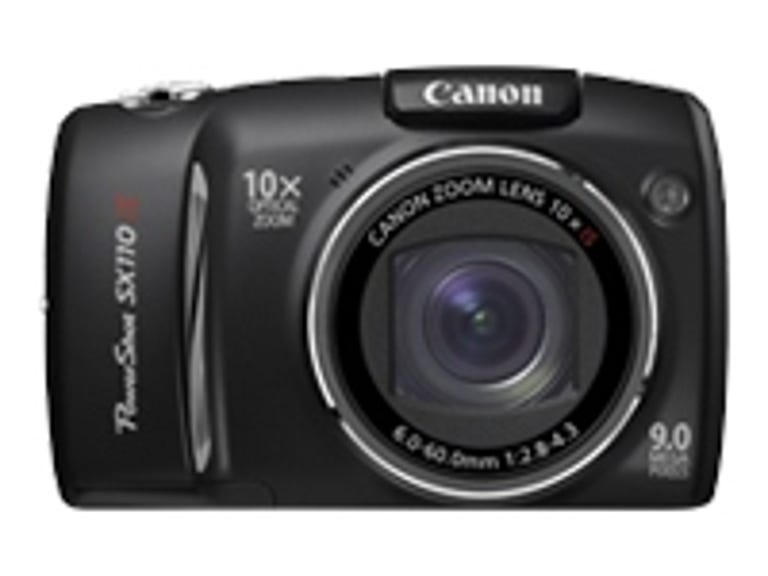 Why You Can Trust CNET
Why You Can Trust CNET Canon PowerShot SX110 IS review: Canon PowerShot SX110 IS
Canon PowerShot SX110 IS
It's very easy to see the appeal of the 9-megapixel Canon PowerShot SX110 IS. It's a reasonably priced, relatively compact megazoom camera with features for casual and seasoned users alike. It also takes great photos for its class. However, as a replacement for the SX100 IS it's a disappointment: Canon didn't address any of the problems we raised with that model, and some aspects of performance even worsened.
The Good
The Bad
The Bottom Line
One of the SX110 IS's biggest lures is its compact size for a megazoom. It measures 4.4 inches wide by 2.8 inches high by 1.8 inches deep and weighs 10.4 ounces and will fit comfortably into a jacket pocket or uncomfortably in a jeans pocket. The optically stabilized 10x f2.8-4.3 36-360mm zoom lens is responsible for most of that weight. Though slightly smaller than the SX100 IS, the SX110 IS remains large enough that it should be easy to hold securely, but its grip is shallow and the body is slippery. Encased in plastic, the SX110 IS nevertheless feels quite solid and sturdy. A door on the bottom covers an SDHC card slot and battery compartment. Unlike most AA-powered megazooms that use four batteries, the SX110 IS is powered by only two, and battery life feels relatively short. You'll want to pick up some rechargeable NiMH batteries for sure.
With the screen now 0.5-inch larger than the SX100's at 3 inches, the PictBridge, face detection, and display and menu buttons once below the LCD have been shuffled a bit. Face detection, display, and menu buttons join the dedicated exposure compensation button above and below the navigational scroll wheel instead of below the LCD. This actually works better since it puts everything under your thumb. The wheel surrounds a Func button and has top, bottom, left, and right pressure points for ISO sensitivity, focus (manual and macro), flash, and drive mode; unfortunately, it retains its all-too-easy-to-change-settings responsiveness. The PictBridge button is now relegated to the far left corner above the screen, while a playback button sits between the right side of the LCD and the slight indent of a thumb rest.
Since the release of the SX100 IS, many megazoom cameras have expanded to a full complement of manual and semimanual exposure modes, flash and exposure compensation, and metering modes, so it's no surprise that the SX110 IS is still fully stocked in that department. There's also the de rigueur handful of scene modes, plus a decent face detection mode that lets you scroll through found faces to select one. It still takes longer to use than simply picking a face and focusing on it.
You do forgo an electronic viewfinder, support for add-on lenses, and a hot shoe with the SX110 IS vs. much of the competition, though I doubt many potential users would really miss any of them. More irritating is the underdeveloped movie capture. While other manufacturers are at least attempting to improve video capabilities, the SX110 IS supports only 30fps VGA without optical zoom and only mono sound.
Though the SX110 IS gets decent marks overall for speed, it does have some borderline performance issues that earned it some ratings demerits. It wakes and shoots in 2.3 seconds, which is typical of megazooms. Its shutter lag for high- and low-contrast scenes--0.5 second and 0.7 second, respectively--are typical for this class, too. However, shot-to-shot times are noticeably slow at 2.1 seconds without flash and jump to 5.1 seconds once you enable the flash. Burst shooting is better, running at 1.3 frames per second. Finally, the LCD is good, but not terrific, and not always easy to see in bright sunlight.
What the camera sacrifices in speed, however, it makes up for in photo quality, even at higher ISOs. Noise starts to show at ISO 400, and at ISO 800 photos have a mottled look, but loss of detail is relatively minimal. Characteristic of megazooms, the lens has some barrel distortion--a surprising amount, given the relatively narrow-angle lens--as well as minor pincushioning, but photos look sharp without looking oversharpened. There's a bit of magenta and purple fringing, but it's only really noticeable in outdoor shots with extreme contrast. Overall it renders excellent exposure and color.
Despite its arguably best-in-class photo quality, the Canon PowerShot SX110 IS's spotty performance, disappointing movie capture, and occasionally frustrating design keep us from giving it an unqualified recommendation.
(Shorter bars indicate better performance)
| Time to first shot | Typical shot-to-shot time | Shutter lag (dim) | Shutter lag (typical) |
(Longer bars indicate better performance)


